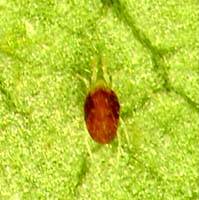


Spider Mites
Common species include Red Spider Mites and Two-Spotted Spider Mites (Tetranychus urticae)
Description
Spider Mites are very tiny arachnids and, as such, have eight legs. They are about 1/100 inch and come in a variety of colors. Red Spider Mites, despite their name, are not necessarily red. They may also be green, yellow, brown or black. Two-Spotted Spider Mites are normally light green with dark spots just behind the head. All Spider Mites feed on the undersides of leaves and produce bronze-colored webs which cover the leaves and stems of African Violets. The damage they cause is compounded by the fact that many mites carry Botrytis.
Distinguishing Symptoms
If your African Violet has these symptoms, it probably has Spider Mites. (Note: In order to make a definitive diagnosis, the bronze-colored webs left behind by Spider Mites should be distinguished from the weblike substance that covers the crown when Crown Rot is present as well as the specks of "cotton" which characterize the presence of Leaf Mealy Bugs.)
Other Symptoms
Treatment
First, isolate all infested plants. This is important, since Spider Mites move quickly from plant to plant.
Next, treat with Dicofol (as directed on the label). You will need to spray three times, once every fourth day after the initial treatment. Be sure that the spray reaches the underside of the leaves, since this is where most Spider Mites tend to concentrate.
As an alternative to traditional chemical treatments, try spraying with Neem (Azadirachtin). Neem is a substance which has natural insecticidal properties, and according to currently available research, it is biodegradable and non-toxic. When sprayed on African Violets, it discourages Spider Mites by making the plant unpalatable. Though Neem does have some systemic effect in plants, spray it as you would other contact insecticides, being sure to spray the undersides of the leaves where Spider Mites tend to cluster.
Prevention
Always isolate new plants until you can positively determine that they are not infested.
Thoroughly wash hands before handling your plants.
Before repotting, pasteurize soil and disinfect pots with a 10 percent bleach solution, i.e., 1 part bleach to 9 parts water.
Important Note on the Use of Pesticides
Please note that almost all pesticides are formulated for specific uses and conditions. When applied incorrectly, pesticides can cause ill health or damage to plants. Therefore, when using any kind of pesticide or chemical treatment, always apply as indicated on the product label.
 |
| Begin New Diagnosis |
| Doctor Optimara Main Page | Glossary of Violet Terms | Contact Optimara |
| Pests, Pathogens and Cultural Problems (Complete List) |
Copyright 1999 Optimara/Holtkamp Greenhouses, Inc. Nashville, Tennessee. Doctor Optimara is a trademark of Holtkamp Greenhouses, Inc. Optimara and the Optimara logo are trademarks of International Plant Breeding, A.G., Switzerland.